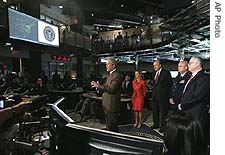2007年VOA标准英语-Protecting America from Terrorism
搜索关注在线英语听力室公众号:tingroom,领取免费英语资料大礼包。
(单词翻译)
By Gary ThomasWashington, D.C.
07 May 2007
Before the attacks of September 11, 2001, U.S. counterterrorist efforts were meager1 compared with those of today, and largely confined to a small cadre of specialists deep inside the intelligence community. Now many government agencies are involved in some aspect of counterterrorism.
| Retired Vice Admiral John Scott Redd, Director of the National Counterterrorism Center |
Genesis of the N.C.T.C.
The N.C.T.C. was created by President Bush in 2004 as a direct outgrowth of the 9/11 attacks. Several investigations5 and commissions all pointed6 out that the terrorists who attacked the World Trade Center and the Pentagon were able to evade7 detection in part because agencies in the secretive intelligence world, protective of their turf and their sources, were not sharing enough information.
In an interview in his office, Scott Redd, the retired admiral whom President Bush chose to head the center, says the Counterterrorism Center exists to ensure that information flows freely, and that analysts8 tracking terrorism have access to the widest intelligence possible.
"What N.C.T.C. does, which is unique, is we bring together all elements of foreign and domestic intelligence relating to the terrorism threat. So by law, any intelligence information relating to terrorism, whether it's foreign or domestic, comes in here," says Redd. "Our job is to make sure that a) people are talking to each other and b) that it is all integrated. We do that in a number of ways. Clearly information-sharing is one of our big jobs."
Inside the N.C.T.C.
In N.C.T.C.'s high-tech9 operations center, intelligence analysts of other federal agencies like the C.I.A., F.B.I., Defense10 Intelligence Agency, and Department of Homeland Security, sit side by side, each in front of several computer screens to connect to their home agency databases. Large plasma11 screens line the walls monitoring different activities, like air traffic and overhead imagery from satellites. The Counterterrorism Center also has its own highly classified, secure web site where information is pooled.
 |
| President Bush at the National Counterterrorism Center in August 2006 |
Coordinating12 U.S. Intelligence
The Counterterrorism Center is unique in that about 95 percent of the people who work there are not actually N.C.T.C. employees. They are analysts sent by their home agency on temporary assignment to the center.
John Brennan, former head of the C.I.A.'s own counterterrorism center, says the advent13 of the N.C.T.C. does not mean the death knell14 for the individual counterterrorism centers in intelligence agencies. "It's not an attempt at all to diminish the capabilities15 of the C.I.A. or the Defense Intelligence Agency or others. The N.C.T.C. is designed, though, to bring together and pool those resources where it makes sense to bring them together."
The N.C.T.C. does not engage in counterterrorism operations; those are left to agencies like the C.I.A. The likes of Jack16 Bauer, the fictional17 counterterrorism agent seen on the American TV series "24," does not reside at the N.C.T.C. But as Admiral Redd says, the center does draw up a strategic government-wide counterterrorism plan, which includes specific operational tasks for each agency.
"We don't do operations, we don't direct the execution of operations. And we also don't collect intelligence here; that's collected by all the other agencies, that comes in here,” says Redd. “We are responsible, however, for the strategic operational planning, for making sure that the plan, once we've developed the plan which we have done and was done about a year ago for the first time in the history of our country, that the plan is being implemented18, and that the plan is ultimately being successful, in other words, assessing it."
Assessing U.S. Counterterror Efforts
There is widespread agreement among independent analysts that the intelligence lapses19 of 9/11 clearly underscored the need for better cooperation and information sharing among agencies. But there is concern in some quarters about the possibility of too much centralization or adding more bureaucracy.
Bill Nolte, former deputy assistant director for analysis at the C.I.A., says cooperation is of course necessary, but agencies still must maintain their unique character and mission. "Any time that you deploy20 resources and say 'our folks have been too scattered,' you run the risk that you will overreact and overconcentrate them. I think that's one of the dangers of this whole post 9/11 situation -- that you'll go from an intelligence community that was insufficiently21 integrated to one that is too centralized," says Nolte.
There has been no successful terrorist attack on U.S. soil since 9-11, and many independent analysts credit that at least in part to the N.C.T.C. But as intelligence officers often say, to succeed in their task, counterterrorism officials have to be lucky 100 percent of the time. But the terrorists only have to be lucky once.
Next time on Focus, we'll look at the personnel challenges facing U.S. counterterrorism and intelligence agencies in the post 9/11 era.
 收听单词发音
收听单词发音 




